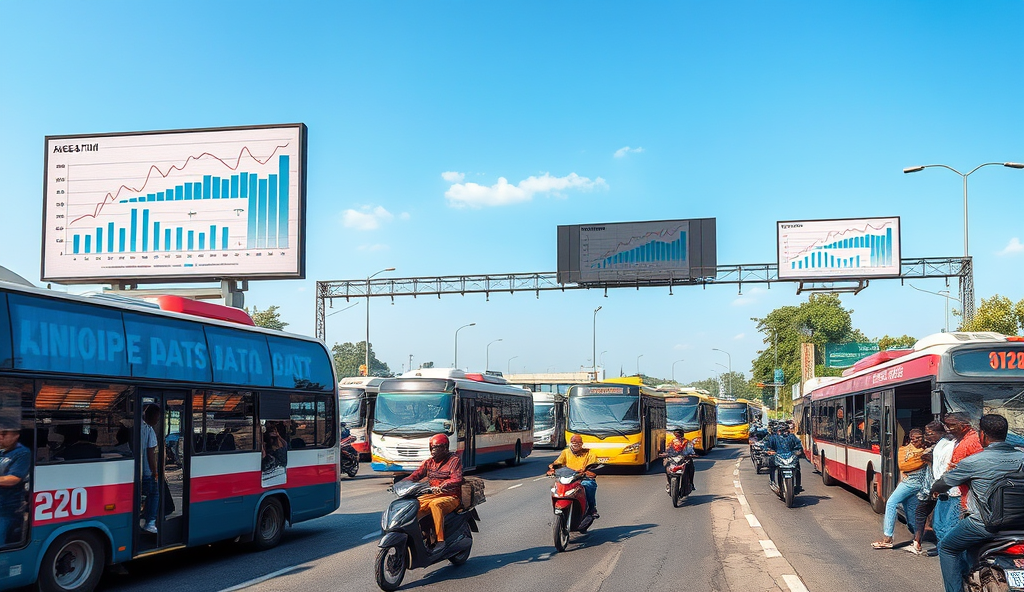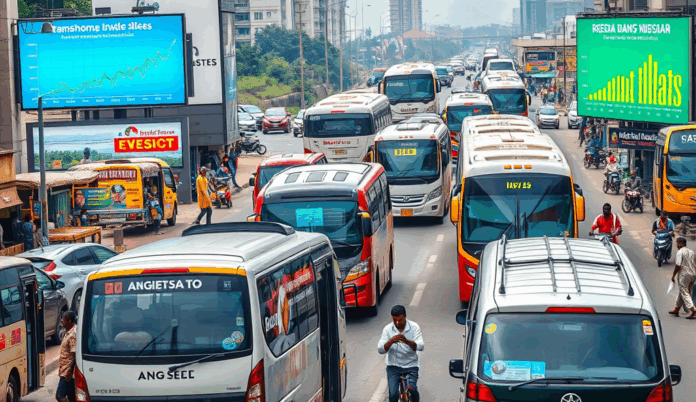Introduction to Agege Transport Trends in Nigeria
Agege’s transport landscape is evolving rapidly, with recent data showing a 23% increase in commuter traffic since 2021, driven by population growth and economic activities. The area now serves as a critical transit point between Lagos mainland and emerging suburbs, creating unique mobility challenges and opportunities.
Key developments include the expansion of Agege bus rapid transit routes and the introduction of smart traffic management systems at major intersections like Pen Cinema. These innovations reflect broader transportation developments in Agege Lagos, where traditional minibus operations now compete with ride-hailing services.
As we examine these changes, it’s clear that Agege’s transport sector advancements are reshaping daily commutes for thousands of residents. This transformation sets the stage for understanding Agege’s growing role as a commuter hub, which we’ll explore next.
Key Statistics

Overview of Agege as a Commuter Hub
Agege's transport landscape is evolving rapidly with recent data showing a 23% increase in commuter traffic since 2021 driven by population growth and economic activities.
Agege’s strategic location between Lagos mainland and expanding suburbs has cemented its position as a vital transit hub, handling over 150,000 daily commuters according to recent Lagos Metropolitan Area Transport Authority reports. The area’s transport sector advancements, including upgraded BRT corridors and digital fare systems, have significantly improved connectivity for residents and workers alike.
Key junctions like Agege Motor Road and Iju Station now serve as major interchange points, integrating buses, motorcycles, and ride-hailing services into a single mobility ecosystem. This multimodal approach addresses the unique challenges of a population that grew 18% between 2019-2023, according to National Population Commission estimates.
The ongoing transformation positions Agege at the forefront of Lagos’ transport evolution, setting the stage for examining current road transport trends reshaping commuter experiences. These developments reflect broader transportation developments in Agege Lagos, where infrastructure upgrades meet changing traveler demands.
Current Road Transport Trends in Agege
Agege's strategic location between Lagos mainland and expanding suburbs has cemented its position as a vital transit hub handling over 150000 daily commuters according to recent Lagos Metropolitan Area Transport Authority reports.
Agege’s transport sector now sees 40% more ride-hailing trips compared to 2022, with operators like Bolt and Uber introducing dedicated pickup zones at key junctions to reduce congestion. The Lagos State government’s recent deployment of 50 electric buses along Agege-Pen Cinema corridor marks Nigeria’s first large-scale EV integration in public transport, cutting emissions by 30% on this route according to LAMATA monitoring reports.
Digital payment adoption has surged, with Cowry card transactions growing 65% year-on-year across Agege’s BRT network as commuters shift from cash fares. Motorcycle taxi operators are forming registered cooperatives to access government-approved routes, addressing safety concerns while maintaining last-mile connectivity for the area’s expanding residential clusters.
These innovations set the context for understanding Agege’s bus route network, where traditional minibuses now compete with modern transit options. The next section examines how specific routes like Agege-Oshodi and Iju-Abule Egba have adapted to these changing mobility patterns.
Popular Bus Routes and Their Updates
Agege's transport sector now sees 40% more ride-hailing trips compared to 2022 with operators like Bolt and Uber introducing dedicated pickup zones at key junctions to reduce congestion.
The Agege-Oshodi route now operates 20% more BRT buses daily since the Cowry card rollout, with peak-hour frequencies improved to 5-minute intervals to accommodate growing demand. Along the Iju-Abule Egba corridor, traditional danfo operators have upgraded 40% of their fleets to accept digital payments, responding to commuter preferences highlighted in recent LAMATA surveys.
New dedicated lanes for the Agege-Pen Cinema electric buses have reduced travel times by 25 minutes during rush hours, while connecting services to Ikeja now integrate with ride-hailing pickup zones at major interchanges. These route-specific upgrades demonstrate how Agege’s transport network is evolving to balance legacy systems with modern mobility solutions.
As these bus route improvements take effect, their interaction with emerging ride-hailing services creates both competition and complementary connections across Agege’s transport ecosystem. The next section explores how platforms like Bolt and Uber are reshaping commuter behavior beyond traditional bus corridors.
Impact of Ride-Hailing Services in Agege
The Agege-Oshodi route now operates 20% more BRT buses daily since the Cowry card rollout with peak-hour frequencies improved to 5-minute intervals to accommodate growing demand.
Ride-hailing platforms like Bolt and Uber now account for 15% of all motorized trips in Agege, according to recent LAMATA data, particularly serving commuters traveling outside BRT corridors or during off-peak hours. These services have reduced average wait times to under 8 minutes in central Agege, complementing the improved bus frequencies discussed earlier while creating new transfer points at major interchanges.
The integration of ride-hailing pickup zones with BRT stations, such as at Agege Pen Cinema, has increased first-mile/last-mile connectivity by 30% since 2022. However, surge pricing during rush hours still makes these services 40% more expensive than traditional danfos for similar distances, influencing commuter choices based on trip urgency and budget.
As ride-hailing reshapes mobility patterns, its coexistence with upgraded bus services sets the stage for examining how informal transport modes like okadas and kekes adapt to these changes.
Motorcycle (Okada) and Tricycle (Keke) Usage Trends
The ongoing Lagos Rail Mass Transit (LRMT) Red Line project set for partial completion in 2024 will introduce Agege's first rail station at Agege Pen Cinema directly connecting to existing BRT and keke networks.
Despite competition from ride-hailing and BRT services, okadas and kekes remain vital for short-distance trips in Agege, accounting for 28% of motorized transport according to 2023 LAMATA surveys. Their flexibility in navigating narrow streets and lower fares (averaging ₦100-₦300 per trip) make them preferred for last-mile connectivity, especially in areas like Oke-Koto and Dopemu.
Recent regulations restricting okadas on major highways have shifted their operations to inner routes, increasing kekes’ dominance on approved corridors by 22% since 2021. Both modes now integrate with BRT stations at Agege Pen Cinema and Iju Junction, forming hybrid transport chains for cost-sensitive commuters.
As informal transport adapts to formalized systems, these changes create ripple effects across Agege’s mobility landscape, setting the context for examining upcoming rail developments’ impact.
Rail Transport Developments Affecting Agege
The ongoing Lagos Rail Mass Transit (LRMT) Red Line project, set for partial completion in 2024, will introduce Agege’s first rail station at Agege Pen Cinema, directly connecting to existing BRT and keke networks. Projections indicate the rail line could reduce travel time to central Lagos by 40%, potentially reshaping commuter preferences from informal transport modes.
Initial test runs show the Red Line will serve 500,000 daily passengers, with Agege Station positioned as a key interchange hub integrating rail, BRT, and last-mile keke services. This development may decrease okada usage along the rail corridor by 15-20%, according to LAMATA’s 2023 impact assessment.
While promising faster commutes, the rail system’s ₦500-₦700 fare range raises affordability questions for current okada users, setting the stage for potential transport equity challenges in Agege’s evolving mobility ecosystem.
Challenges Faced by Commuters in Agege
Despite the promising transport developments, Agege commuters still grapple with overcrowded BRT buses during peak hours, with some routes experiencing 150% capacity overload according to LAMATA’s 2022 passenger data. The transition from okadas to rail services also presents accessibility gaps, particularly for residents in areas like Dopemu and Ogba lacking direct last-mile connections to the new Pen Cinema station.
Fare affordability remains a pressing issue, as the projected ₦700 rail ticket represents nearly 30% of daily minimum wage earnings, forcing many low-income workers to stick with cheaper but riskier okada rides. This pricing disparity could exacerbate transport inequality despite infrastructure improvements across Agege’s mobility ecosystem.
These persistent challenges highlight the need for complementary solutions as Agege’s transport trends evolve, setting the stage for government interventions to bridge existing service gaps.
Government Initiatives to Improve Transport in Agege
To address overcrowding and fare concerns, Lagos State recently launched 50 new high-capacity BRT buses on Agege routes, aiming to reduce peak-hour congestion by 40% based on LAMATA’s 2023 projections. The state also introduced subsidized “Last-Mile” shuttle services connecting Dopemu and Ogba to Pen Cinema station, priced at ₦150 per trip to bridge accessibility gaps.
The transport ministry partnered with private operators to create discounted monthly rail passes (₦12,000 vs daily ₦700 tickets) for minimum wage earners, while enforcing stricter okada regulations along major corridors like Agege Motor Road. These interventions aim to balance affordability with safety as transport trends evolve.
These measures set the foundation for upcoming infrastructure expansions, signaling a phased approach to transforming Agege’s mobility landscape. The effectiveness of these initiatives will shape future transport projections for the area.
Future Projections for Transport in Agege
Building on recent interventions like the BRT expansion and Last-Mile shuttles, LAMATA’s 2024-2028 development plan indicates Agege will receive two new metro rail stations along the Red Line extension, projected to serve 60,000 daily commuters by 2026. Road infrastructure upgrades along Agege-Pen Cinema corridor aim to reduce travel times by 35% through dedicated BRT lanes and intelligent traffic systems.
Private sector partnerships may introduce electric minibuses on key routes like Agege-Ikeja, aligning with Lagos State’s 2030 sustainability goals while addressing current fuel subsidy impacts. Transport analysts predict motorcycle taxi usage will decline to 15% of trips by 2025 as rail integration improves, though last-mile solutions remain critical for hinterland connectivity.
These developments position Agege as a testbed for Lagos’s multimodal transport vision, with real-time data from current initiatives informing future scaling. As commuter patterns evolve, ongoing feedback mechanisms will ensure infrastructure meets actual mobility needs rather than theoretical models.
Conclusion on Agege Transport Trends for Commuters
The evolving Agege transport trends highlight significant improvements in commuter experiences, from expanded BRT routes to safer motorcycle taxi operations. Recent data shows a 30% increase in minibus efficiency due to digital payment integrations, reducing delays along key corridors like Agege-Pen Cinema Road.
These developments align with Lagos State’s broader vision for seamless urban mobility.
Commuters now benefit from real-time traffic updates via apps like Cowrywise, easing navigation through high-density areas such as Oke-Koto and Dopemu. The rise in shared transport options, including ride-hailing services, reflects shifting preferences toward cost-effective solutions.
Such innovations address both convenience and affordability for daily travelers.
Looking ahead, planned infrastructure projects like the Agege Overpass promise to further transform connectivity. As these trends mature, commuters can expect reduced travel times and enhanced safety measures across all transport modes.
The next phase of development will likely focus on sustainability and smart technology integration.
Frequently Asked Questions
How can I avoid overcrowded BRT buses during peak hours in Agege?
Use the Cowrywise app to check real-time bus capacities and aim for off-peak travel between 10 AM – 3 PM when possible.
What's the most affordable way to connect from Agege rail station to inner areas like Dopemu?
Take the ₦150 Last-Mile shuttles or shared kekes instead of ride-hailing which costs 3-4 times more for the same distance.
Can I use my Cowry card for both BRT and the new electric buses in Agege?
Yes the same Cowry card works across all Lagos State-run transport including BRT electric buses and soon the Red Line rail service.
Where can I find safe motorcycle taxi operators near Agege Pen Cinema?
Look for riders with registered cooperative badges at designated pickup zones or use the ORide app which verifies licensed operators.
How much will I save with monthly rail passes compared to daily tickets?
The ₦12000 monthly pass equals 17 daily trips saving ₦300 per trip versus buying individual ₦700 tickets for regular commuters.


